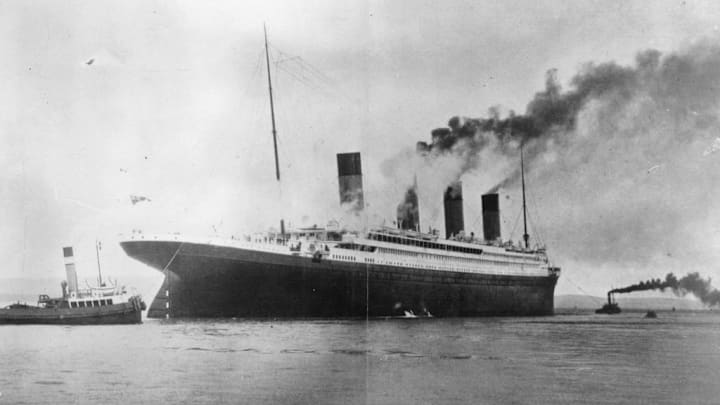The maiden voyage of the Titanic was a tragedy that shook the world. More than 1500 people lost their lives on April 15, 1912—a sorrowful end for a luxury liner once believed to be virtually unsinkable.
The suffering and distress of all of those aboard inspired lawmakers to take action, and several new regulations were put into place to keep passengers safe when sailing the high seas, including the Radio Act of 1912 and the first version of the Safety of Life at Sea (SOLAS) treaty. Here, we’ll examine how some of the new maritime laws imposed helped prevent a catastrophe of this magnitude from happening again.
1. Ships are now required to provide enough lifeboats for all passengers.

One of the defining tragedies of the Titanic sinking was that there were not enough lifeboats for all of the approximately 2200 people aboard, and only 705 were saved. While the ship could have fit 64 lifeboats in total, there were only 20 on it. These vessels still could have accommodated about a third of the individuals on board (roughly 1178 people), had the "women and children first" principle not been strictly enforced.
But perhaps the most shocking part of all? That was four more lifeboats than were legally required. At the time, the number of mandated lifeboats on a liner was determined by a ship's gross tonnage, not the number of passengers it carried. Under the UK's Board of Trade, British ships weighing greater than 10,000 tons were only required to carry a minimum of 16 lifeboats. (The Titanic, for reference, had a gross tonnage of 46,328 and could displace between 52,000 and 66,000 tons of water.)
Following the tragedy, there were limitation of liability hearings in both the United States and the UK, and it was recommended that ships carry enough lifeboats to accommodate all passengers and crew members aboard. With the creation of the first SOLAS treaty in 1914, this became an international standard.
2. Radio waves were more firmly regulated—and ships now have 24-hour radio watches.
Another factor that contributed to the Titanic disaster was that radio signals were unregulated at the time. Chief telegraphist Jack Phillips sent a CQD Morse code distress call (the standard distress signal used by Marconi operators, the telegraph company that Phillips worked for; later, he used SOS, which was still relatively new at the time) after the ship struck an iceberg at 11:40 p.m. on April 14, 1912.
The CQD call was heard by a Newfoundland telegraph station, however, the airwaves were clogged by radio noise, which was caused by amateur operators on the East Coast in the United States, and by personal telegrams still being sent to the ship that were intended for passengers. Compounding this, the wireless radio operator of the SS Californian, a merchant vessel about 10 miles away from the Titanic, had gone to bed, so the sinking liner's urgent calls for help went unanswered.
The Radio Act of 1912 changed passengers' safety at sea in very significant ways. The U.S. law placed restrictions on the use of long-wave frequencies, requiring radio operators to be licensed. The U.S., which by 1912 had yet to formally adopt SOS as the international distress signal, began using it officially. Per the SOLAS treaty of 1914, ships were required to have a wireless radio operator on watch at all times. Distress signals were also given priority over airwaves, and with the Communications Act of 1934, a separate radio frequency was established for them.
3. The International Ice Patrol was formed.

The Titanic's demise led to the first International Convention for Safety of Life at Sea in London in 1913, with the original treaty going into effect on January 20, 1914. The initial SOLAS, as it would come to be known (it was later amended and updated in 1929, 1948, 1960, and 1974, respectively), instituted a number of important maritime regulations, including 24-hour radio watches and the number of lifeboats required on ships. Additionally, it mandated that all crew members be drilled on how to properly load and deploy lifeboats.
Another entity that it established was the International Ice Patrol, which was created to locate and warn ships of dangerous icebergs in the North Atlantic, around the Grand Banks off Newfoundland. It's still in existence today, and tracks about 1000 icebergs each year. Since the patrol’s inception, no lives have been lost within its surveillance area as a result of iceberg collisions.
4. Ships are now designed with safety in mind.
While many considered the Titanic “unsinkable,” it was completely the opposite. The liner featured a double bottom and 16 watertight compartments, which were outfitted with watertight doors that were electric and could all be closed at the same time or one by one using a switch on the ship's bridge. While they were watertight, the walls of each bulkhead were only a few feet above sea line, so it was easy for the water to spill over and cause the ship to plunge forward.
Following the calamity, many fundamental design changes to ships were made. The White Star Line, which owned and operated the Titanic, modified the designs of sister ships the RMS Olympic and RMS Britannic so that the double bottoms were extended above the waterline, resulting in double hulls. This meant that if the hulls were punctured—be it by an iceberg or a collision of some other kind—water would be less likely to pour into the watertight compartments. Another significant change to ship design after the sinking of the Titanic was bringing the bulkheads higher above the waterline, so that each compartment would truly be watertight.
